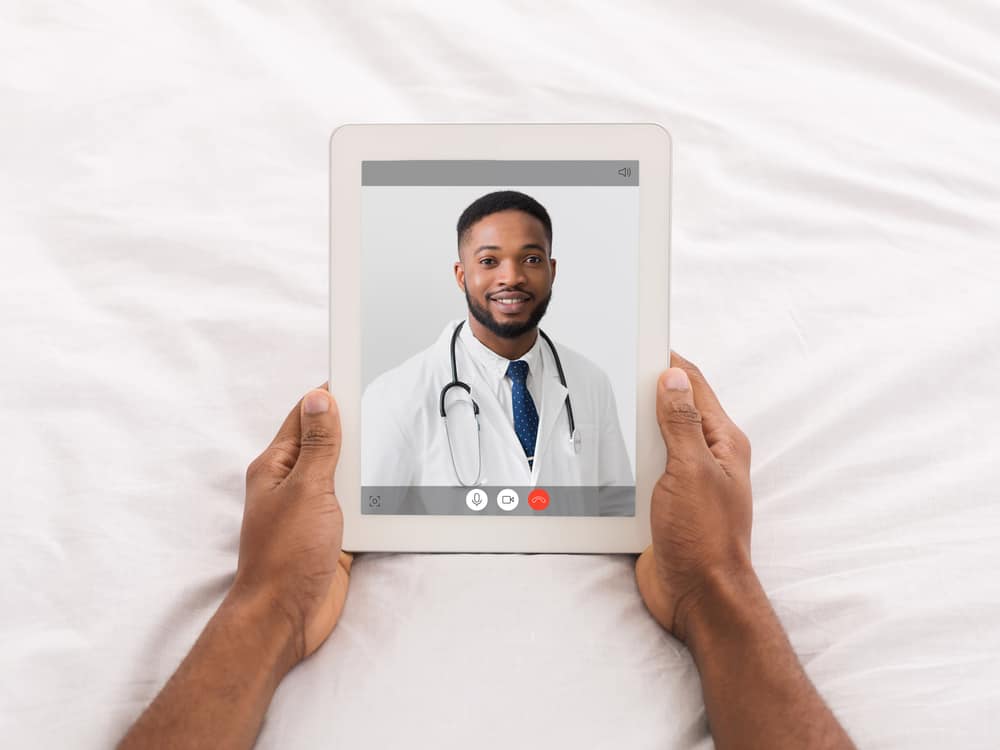COVID-19 has created an unprecedented shift towards all things digital. Millions of employees have been working from home over the last several weeks. Education has also moved online and highlighted quite a few disparities along the way.
Unsurprisingly, telehealth visits have become more popular – and more normalized – as the healthcare community continues to battle COVID-19, especially after the Centers for Medicare & Medicaid Services (CMS) relaxed guidelines on it.
“Habits that we form now will grow into preferences and default behaviors, and patients won’t want to return to a pre-COVID-19, less-convenient form of in-person healthcare,” says Bob Kocher, MD, physician and member of California’s new public-private coronavirus testing task force. “Doctors, too, will prefer telemedicine because it enables them to spend more time doing what they like—caring for patients.”
Virtual healthcare has always had great potential for millions of Americans, especially those who live in communities far from specialists or who were unable to travel to hospitals and medical centers. In this guide, we’ll look at coding virtual care during COVID-19 and best practices for these visits.
Latest guidance on virtual care
The current pandemic has strained healthcare systems around the country. CMS has removed restrictions on telehealth to help alleviate that.
To reduce patient exposure to the virus and to protect the local community and healthcare workers, CMS has also agreed to to pay for a wider range of virtual services furnished during the current pandemic. This includes reimbursing virtual services provided retroactive from January 27, 2020, until June 30, 2020. Healthcare leaders have urged that telehealth options become part of the new normal both in treating COVID-19 and beyond.
Virtual options: an overview
Before COVID-19, CMS authorized telehealth claims in certain circumstances such as routine visits. Medicare recipients in designated rural areas with limited access to care could see participating healthcare professionals. However, Medicare did require patients to travel to a local facility for the virtual appointment to take place.
CMS also authorized limited Medicare reimbursement for certain communications, virtual check-ins, and for e-visits.
On March 6, 2020, CMS invoked its authority to change these policies, relaxing most telehealth regulations and opening up more avenues for provider reimbursement. These changes will last the duration of the COVID-19 pandemic. Likewise, CMS made additional changes to ensure patients have access to the care they need during this time.
Telehealth criteria are focused on these 6 areas:
- Virtual check-in
- E-visits (Online digital evaluation and management)
- Remote monitoring
- Telephone calls
- Allowed telehealth services
- Modifiers

Who can provide telehealth services?
The majority of healthcare professionals are allowed to provide telehealth services. Physicians, nurse practitioners, or physicians’ assistants, along with social workers, clinical psychologists, and others may perform care.
For a full list of services that may be performed via telehealth, check this CMS fact sheet.
Is it possible to waive cost sharing?
Policy changes do not require providers to waive copayments and deductibles. Providers may apply and collect these from beneficiaries.
Coding basics: an overview
New coding guidance has been issued by 4 cooperating parties: the American Hospital Association (AHA), the American Health Information Management Association (AHIMA), the Centers For Disease Control and Prevention (CDC), and National Center for Health Statistics (NCHS).
This checklist from the American College of Physicians provides a look at coding guidance for video visits with patients. Final COVID-19 coding guidance from AHA and AHIMA in collaboration with the ICD-10 Maintenance and Coordination Committee with CDC is as follows:
87635: This is the code for “infectious agent detection by nucleic acid (DNA or RNA); severe acute respiratory syndrome coronavirus 2 (SARS-CoV-2) (Coronavirus disease [COVID-19], amplified probe technique.”
87471: This is the parent code that 87635 falls under and denotes “infectious agent detection by nucleic acid (DNA or RNA); Bartonella henselae and Bartonella quintana, amplified probe technique in the 2021 CPT® code set.”
U07.1: This code is from the the CDC and directly addresses the AHA’s request for the HHS Secretary to implement unique codes for testing, screening, and exposure to COVID-19.

In-person exams
New patient visits do not require previous in-person visits. Clinicians will select a level of services based on either patient medical records, exam, counseling, and/or other necessary medical decision making.
What are the telehealth codes?
- G2010: for remote evaluation of recorded images or videos along with interpretation within 24 hours
- G2012: for brief communication technology-based service, e.g., virtual check-in, by a physician or other qualified health care professional who can report E&M services; documentation requirements include:
-
-
- confirmation that patients are established patients
- confirmation that the reason for the visit can’t be related to an office visit in the previous 7 days
- can’t result in being seen for a next available office appointment or within 24 hours
- must have 5 to 10 minutes of medical discussion
-
-
- CPT codes 99201 to 99215: these codes are commonly used for an office or other outpatient visit and can be used for telemedicine visits as well; however, they will require doctors meet 2 of the 4 following requirements in order to receive full reimbursement:
-
- be a low complexity medical decision-making visit
- offer an expanded, problem-focused exam
- have an expanded, problem-focused medical history
- spend 15 minutes face-to-face with the patient
-
Online digital evaluation and management:
- 99421: for patient-initiated digital evaluation and management service, for an established patient, for up to 7 days, the cumulative time during the seven days is 5-10 minutes
- 99422: for visits 11-20 minutes
- 99423: for visits 21 minutes or longer
- 99453: for remote monitoring of physiological parameters; set-up and patient education on the use of equipment
- 99454: for remote monitoring of physiologic parameter(s) (e.g., weight, BP, pulse oximetry, respiratory flow rate) initial; device(s) supply with daily recording(s) or programmed alert(s)
- 99457: for remote physiologic monitoring treatment management services, 20 minutes or more of clinical staff, physician, or other qualified health professional time in a calendar month requiring interactive communication with the patient/caregiver during the month
Telephone calls (provided by qualified non-physician healthcare provider):
- 98966: for telephone assessment and management service provided by a qualified non-physician, healthcare professional to an established patient, parent, or management service provided within the previous 7 days nor leading to an assessment and management service or procedure within the next 24 hours or soonest available appointment; 5-10 minute medical discussion
- 98967: for visits 11-20 minutes
- 98968: for visits 21-30 minutes
Telephone calls (provided by a physician):
- 99441: for telephone E/M service provided by a physician to an established patient, not originating from a related E/M service provided within the previous seven days nor leading to an E/M service or procedure within the next 24 hours. or soonest available appointment; 5-10 minute medical discussion
- 99442: for visits 11-20 minutes
- 99443: for visits 21-30 minutes
- All eligible codes should use modifier -95 to claim lines of services delivered via telehealth.
Advancing normalization of virtual
Although providers should keep a sharp eye on the latest changes in virtual visits and needs, we can expect that such options will continue to grow beyond COVID-19.
This change is a net positive for both physicians and patients. Virtual care allows patients to receive care when they may not be physically able to attend physical office visits. Similarly, it enables healthcare providers greater flexibility in care delivery both to these types of patients and to those who don’t live locally and/or have mobility issues or other obstacles to receiving care.
It’s too early to assume this will be the future of all forms of care, but it certainly is trending in that direction. Even prior to the pandemic and with associated regulations, telemedicine services had already grown to over $38 billion in value. A recent Global Market Insights reports notes that by 2026 the telemedicine market is set to be valued at $175.5 billion.

Concerns for preventing the next outbreak as well as for providing more options for care will likely encourage this trend to develop further.
Looking ahead
It’s challenging to look beyond what we’re currently facing, but it’s crucial that healthcare systems prepare for changes in the landscape. Now is the time to invest in coding, auditing, and data analytics solutions that will enable a successful adapt to this evolution in healthcare delivery.
To keep up with the change of pace, hospitals will need to evaluate their approach to determine the impact of the COVID-19 pandemic and the resulting push into new delivery modalities.
Coding virtual visits during COVID-19 is only the beginning. This unprecedented time in healthcare history is as an opportunity for healthcare systems to position themselves for success in a new era of care.
We’re here to empower your organization
The team here at Harmony Healthcare can assist you with a program to validate and advise if the documentation for the care that was provided during COVID-19 meets CMS expectations.
Our team of credentialed and experienced coding and documentation auditors will review a mixed sample of telehealth/video visits your clinicians provided. Then, through our streamlined reports, we will provide details of findings and educate in areas of weakness that may require improvement.
Our coding and documentation audit professionals can review both the professional fee telemedicine/telehealth services provided (with claim data) or the hospital outpatient department (from the April 30th Interim Final Rule and new waivers retro to March 1st) telemedicine/telehealth services provided (with claim data).
Subscribe to our monthly newsletter here.
Find us on Facebook here.
Join our LinkedIn community here.



